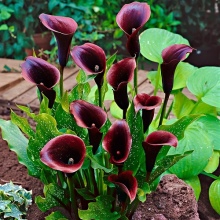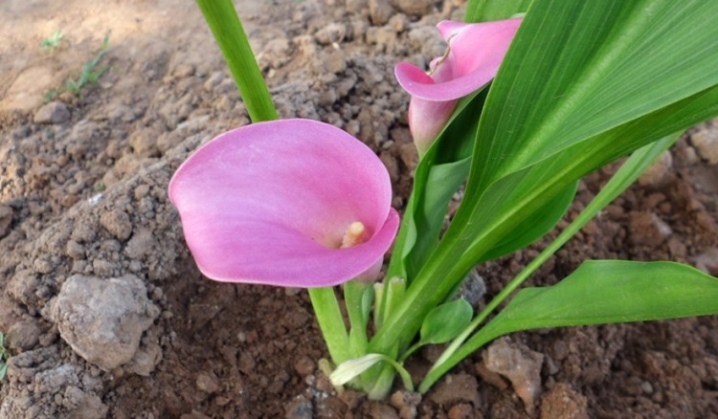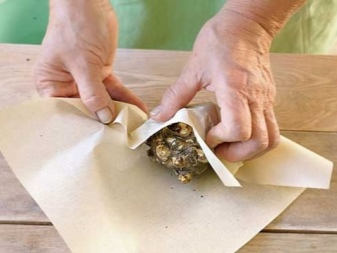Garden callas: description, types and recommendations for growing

If you want to plant a beautiful flower bed, then a flower like calla can be a great decoration in your country house or in your backyard. Varieties with white petals are usually called wedding varieties, since their shape resembles a bride's outfit. Many varieties of this plant species can be found more and more often in Russia. If you organize the planting process correctly and properly care for your garden flowers, then they will grow quickly and bloom for a long time.
As the experience of experienced gardeners shows, all that is needed to grow callas in their flower beds is just knowing a few simple rules about planting and caring for them. You can read about all this and not only in our article.

What it is?
Garden calla is a rather unpretentious type of plant, if you adhere to certain conditions of care. One of the main difficulties that you may face when growing garden calla lilies is its storage during the winter cold. It is very important for this type of plant to be dormant when it is winter outside.
It is worth noting that this type of flower can be grown both at home, that is, in a pot on the windowsill, and in the open field in a flower bed. The flowering period is from June to September.
If you grow calla lilies in a pot and with the onset of light autumn cold weather you bring your plant into a warm room, then the flowering period will be longer.


Since this flower is native to South Africa, its natural habitat is the banks of bodies of water, such as a river or lake. Also, in nature, such a flower can be found growing in heavy muddy soil.
That is why it is preferable to plant decorative "relatives" of this type of flower in slightly darkened places with high humidity.


By planting calla lilies in your yard, you will get a kind of rug of stems and foliage, from which flower stalks will grow during the flowering period. Therefore, it is best to choose a relatively open place for planting, where the plant can grow magnificently. How can you place your "green friend" in an open and dark area at the same time? The fact is that calla can grow in both cases, the differences will be as follows:
- in a darkened area, this type of flower will be characterized by rapid flowering;
- in more open and sunny areas, you can grow a plant with beautiful foliage but less lush flower stalks.
In any case, the choice is yours - whichever variety or place for planting you choose, garden calla will be a wonderful decoration for any flower bed.



Views
Street calla, or, as it is also called, calla, is a representative of the genus of the aroid family. Previously, this genus was understood more broadly, which is why most of the aroid species that are grown as a houseplant or for cutting are called calla lilies. First of all, such a name is typical for plants from South Africa - Zantedesky, in particular, for Elliott Zantedeschia and Ethiopian Zantedeschia.
We bring to your attention some of the most popular varieties of Ethiopian calla lilies and Elliott calla lilies among gardeners, with the help of which you can realize even the most daring ideas and make your flower bed unusually beautiful.

- Calla "Amethyst". Since ancient times, this variety has been considered one of the best plants that can be used to decorate the chambers of a noble lady. Distinctive features are a pleasant and refined aroma during the flowering period of the plant, as well as the color of the petals - delicate violet. The height of a flower depends entirely on the conditions of its cultivation: it can reach from 60 centimeters to 1.2 meters.
The peduncle itself grows, as a rule, quite tall and strong.


- Calla "Vermeer". It is a beautiful flower with a variety of colors and contrasts. The flower itself has a dark red color, and along the edges it turns into a snow-white edging. Deep-colored petals cover the bright yellow ear of the plant, thereby creating a contrast of colors. The foliage of this garden calla variety is characterized by a white speck. The growth of Vermeer calla lilies will not exceed 70 centimeters.


- Ethiopian rhizome calla. It is better to plant this type of flower in an area with a high level of humidity, then it can quickly take root. Also loves slightly shaded areas. The flowers of the Ethiopian rhizome calla are large and have a pleasant white shade.
This variety of garden calla lilies will look great and grow in an artificial pond with other types of aquatic plants.


- Tuberous calla lilies. Unlike the previous variety, tuberous calla lilies do not need moist soil to take root and feel comfortable. Such flowers can be planted in a flower garden. Like many other calla varieties, this one is preferably planted in a darkened area.
However, on the open sunny side, he will also be able to take root, only his growth will be much lower compared to those that will grow in partial shade.

After familiarizing yourself with the most common varieties of garden calla lilies, you can choose the one that works best for your soil and terrain.


Reproduction methods
Calla lilies can be purchased at the end of February. If you decide to buy exactly the root tuber, then you definitely need to pay attention to its appearance. It must be dense - otherwise, the plant will not be able to produce flower stalks in the same year when it is planted. Experts recommend completely abandoning the purchase of a flower, the tuber of which looks stale, slightly wilted. You will need to plant flowers in the spring, so if you bought rhizomes in winter, then you need to provide them with reliable and correct wintering.
There are several ways to reproduce garden calla lilies. A detailed description of possible methods is offered to your attention.

Rhizome division
- The landing period is April.
- The landing site is a pot, the capacity of which should be up to 3.5 liters.
- Temperature range from + 20 ° C to + 22 ° C.
- Watering is carried out not immediately after planting, but after a week. Then you need to constantly monitor that the soil does not become too dry, and in a timely manner to fill your plant with moisture.
For tree species, it is best to resort to the reproduction process by dividing the rhizomes. At the same time, it is important to try to keep as much soil as possible on the roots so that they do not dry out. Further, the resulting rhizomes must be planted in separate pots. They should be stored at a special temperature regime - from + 12 ° C to + 15 ° C.
With the arrival of spring, shoots should appear, and already at the beginning of the summer season it will be possible to plant your flower in open ground.


If you do not have the opportunity to plant plants using this method, then you can simply buy seedlings in any nursery.
Sowing for seedlings
To get beautiful calla lilies in this way of reproduction, you should adhere to the following recommendations.
- The seeds should be soaked in a solution of a natural biostimulant (potassium humate) for almost 6 hours.
- Then you need to put your seeds on a pre-moistened textile and cover with another damp piece of cloth on top.
- In this form, the seeds should be stored for about 7 days.The place should be warm and dry. From time to time, you need to rewet the textiles so that the seeds do not dry out.
- After that, they can be planted in open soil.


Planting and leaving
It is necessary to plant calla lilies in accordance with their appearance, be it a tuber or a rhizome. If in the first case it is possible to resort to planting and cultivation thanks to the separation of "children", then in the case of the rhizome it is necessary to dwell on the method of dividing the bush. At the same time, in both options, planting with the help of seeds is possible.
To grow a beautiful outdoor plant, it must be properly cared for. Use a different kind of fertilizer periodically. You need to feed at least once every two to three weeks. During the flowering period, it is best to use potassium (no more than 20 g). Also, do not get too carried away with fertilizers, which include nitrogen substances, as they contribute to the acceleration of leaf development. For flower stalks, potassium is considered the best fertilizer.
Watering is another important aspect of calla lilies care. It should be done frequently, but not in large volumes. In order to stimulate the roots, gardeners recommend resorting to cutting the peduncles after the end of the flowering period. As for the young growth, it is not necessary to cut it.
Thus, garden calla is a rather unpretentious and very attractive plant that can beautify any area.


Storing tubers in winter
Since the plant itself is South African, it is very difficult for it to endure the harsh climate of Russia. That is why, already with the arrival of September, it is imperative to start preparing calla tubers for wintering. In winter, severe frosts can damage the root structure of the flower. Experienced gardeners strongly recommend digging up calla tubers before the onset of the winter cold. Let's take a look at the main stages of preparing tubers for storage in the winter.
- First of all, you need to carefully get the tubers out of the soil, and then shake them off from the remnants of the earth and rinse under cold water. Plants can have rather thin and fragile roots, so this step must be done with extreme care.
- Further, during the first 14 days, the root tubers of garden calla lilies should be stored together with the foliage in a cool place, where the temperature will constantly be between + 5 ° C and + 15 ° C.
- In two weeks, all kinds of nutrients from the leafy part will pass into the root tubers. Already on the fifteenth day, it will be possible to eliminate wilted roots and foliage.


After carrying out all the above stages, the plants are completely ready for long-term storage during the winter frost. What should be the storage conditions for the root tubers of garden calla lilies?
- Stable temperature conditions in the place where the tubers will be stored in winter.
- Safe place. You can place plants for wintering in a cellar, basement, balcony or even in a refrigerator (if you set the desired temperature beforehand).
- Each rhizome should be wrapped in a paper wrapper.


As for the lighting and the humidity level of the place in which the root tubers will be stored, this aspect is not so important. If all the preliminary stages were performed correctly, then their quality characteristics will not change in any way when it comes time to get the plants after wintering. There is only one thing left - to correctly complete the wintering process of calla lilies. Plants usually "wake up" in early April or early March, depending on the region of your residence. Follow the instructions below:
- root tubers must be removed from the paper wrapper and inspected for any fungal diseases;
- further, you need to take a solution of manganese (you can use any other fungicide) and process the plant;
- if the “kids” were not separated before the start of wintering, then this can be done now.
You can learn how to care for garden carls by watching the video below.




































































































Thanks. The material is complete enough for growing and caring for the plant. I really want to grow such a flower in the garden.
Thank you very much, everything is clear, very interesting, I bought two plants, we will take care of this beauty.
I have one already blooming.
The comment was sent successfully.